audio Seat Toledo 2014 SOUND SYSTEM 1.X
[x] Cancel search | Manufacturer: SEAT, Model Year: 2014, Model line: Toledo, Model: Seat Toledo 2014Pages: 37, PDF Size: 0.78 MB
Page 15 of 37
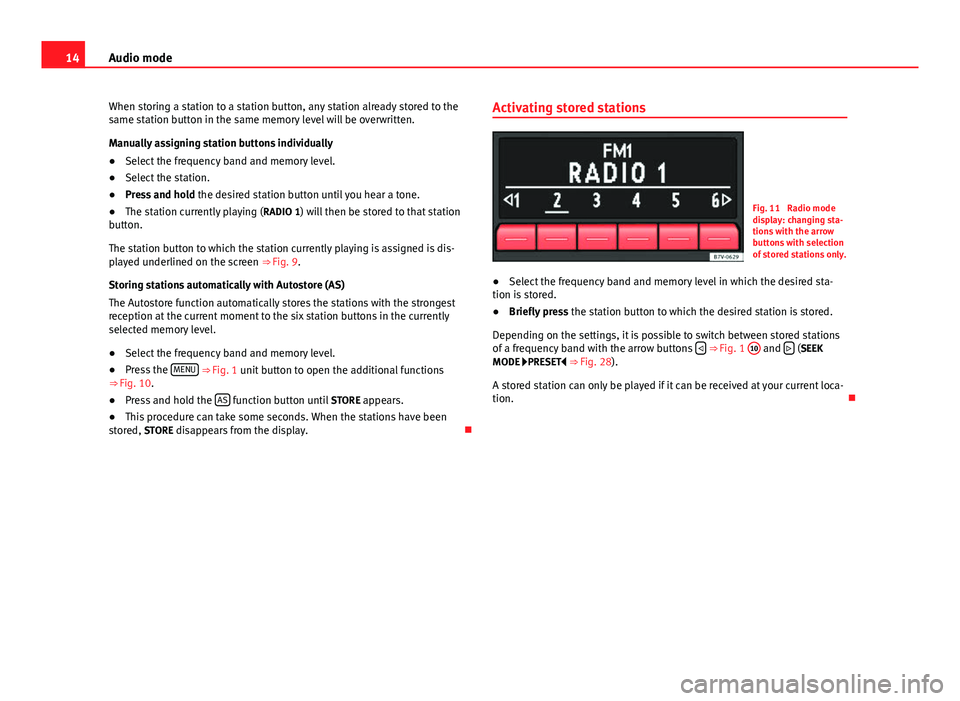
14Audio mode
When storing a station to a station button, any station already stored to the
same station button in the same memory level will be overwritten.
Manually assigning station buttons individually
● Select the frequency band and memory level.
● Select the station.
● Press and hold the desired station button until you hear a tone.
● The station currently playing ( RADIO 1) will then be stored to that station
button.
The station button to which the station currently playing is assigned is dis-
played underlined on the screen ⇒ Fig. 9.
Storing stations automatically with Autostore (AS)
The Autostore function automatically stores the stations with the strongest
reception at the current moment to the six station buttons in the currently
selected memory level.
● Select the frequency band and memory level.
● Press the MENU
⇒ Fig. 1 unit button to open the additional functions
⇒ Fig. 10.
● Press and hold the AS
function button until
STORE appears.
● This procedure can take some seconds. When the stations have been
stored, STORE disappears from the display. Activating stored stations
Fig. 11 Radio mode
display: changing sta-
tions with the arrow
buttons with selection
of stored stations only.
● Select the frequency band and memory level in which the desired sta-
tion is stored.
● Briefly press the station button to which the desired station is stored.
Depending on the settings, it is possible to switch between stored stations
of a frequency band with the arrow buttons
⇒ Fig. 1 10 and
(SEEK
MODE PRESET
⇒ Fig. 28).
A stored station can only be played if it can be received at your current loca-
tion.
Page 16 of 37
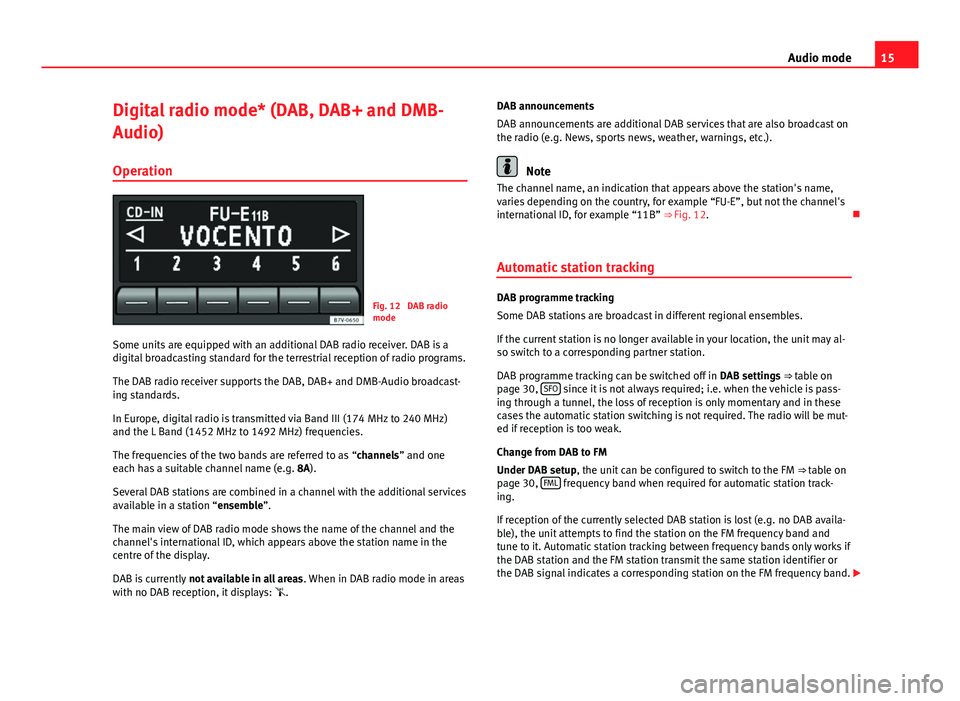
15
Audio mode
Digital radio mode* (DAB, DAB+ and DMB-
Audio) Operation
Fig. 12 DAB radio
mode
Some units are equipped with an additional DAB radio receiver. DAB is a
digital broadcasting standard for the terrestrial reception of radio programs.
The DAB radio receiver supports the DAB, DAB+ and DMB-Audio broadcast-
ing standards.
In Europe, digital radio is transmitted via Band III (174 MHz to 240 MHz)
and the L Band (1452 MHz to 1492 MHz) frequencies.
The frequencies of the two bands are referred to as “channels” and one
each has a suitable channel name (e.g. 8A).
Several DAB stations are combined in a channel with the additional services
available in a station “ensemble”.
The main view of DAB radio mode shows the name of the channel and the
channel's international ID, which appears above the station name in the
centre of the display.
DAB is currently not available in all areas . When in DAB radio mode in areas
with no DAB reception, it displays: . DAB announcements
DAB announcements are additional DAB services that are also broadcast on
the radio (e.g. News, sports news, weather, warnings, etc.).
Note
The channel name, an indication that appears above the station's name,
varies depending on the country, for example “FU-E”, but not the channel's
international ID, for example “11B” ⇒ Fig. 12.
Automatic station tracking
DAB programme tracking
Some DAB stations are broadcast in different regional ensembles.
If the current station is no longer available in your location, the unit may al-
so switch to a corresponding partner station.
DAB programme tracking can be switched off in DAB settings ⇒ table on
page 30, SFO
since it is not always required; i.e. when the vehicle is pass-
ing through a tunnel, the loss of reception is only momentary and in these
cases the automatic station switching is not required. The radio will be mut-
ed if reception is too weak.
Change from DAB to FM
Under DAB setup, the unit can be configured to switch to the FM ⇒ table on
page 30, FML
frequency band when required for automatic station track-
ing.
If reception of the currently selected DAB station is lost (e.g. no DAB availa-
ble), the unit attempts to find the station on the FM frequency band and
tune to it. Automatic station tracking between frequency bands only works if
the DAB station and the FM station transmit the same station identifier or
the DAB signal indicates a corresponding station on the FM frequency band.
Page 17 of 37
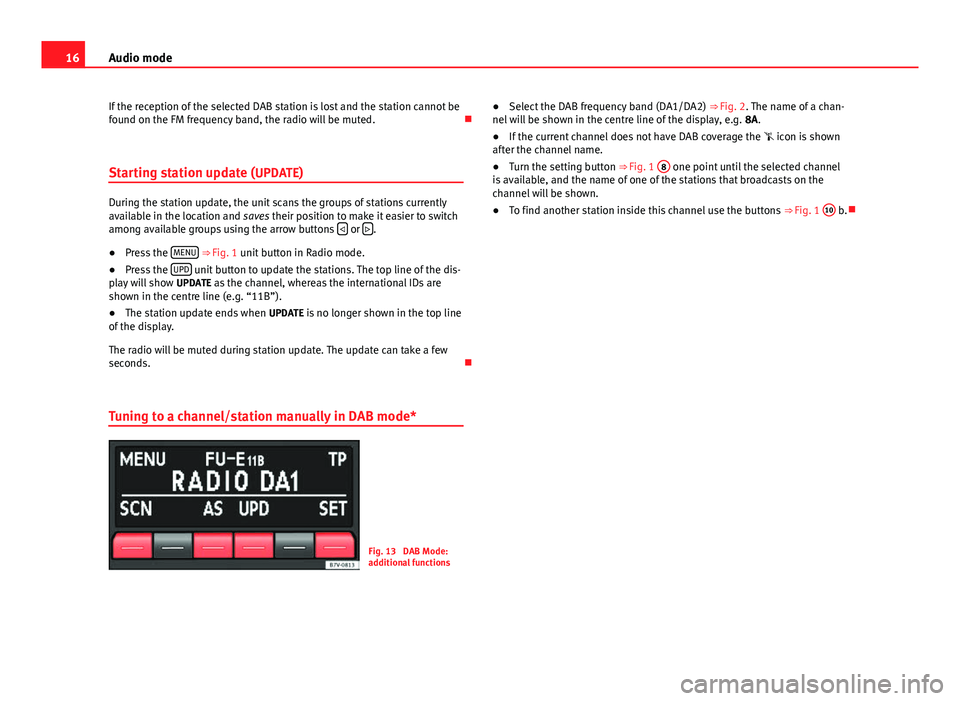
16Audio mode
If the reception of the selected DAB station is lost and the station cannot be
found on the FM frequency band, the radio will be muted.
Starting station update (UPDATE)
During the station update, the unit scans the groups of stations currently
available in the location and saves their position to make it easier to switch
among available groups using the arrow buttons
or .
● Press the MENU
⇒ Fig. 1 unit button in Radio mode.
● Press the UPD unit button to update the stations. The top line of the dis-
play will show UPDATE as the channel, whereas the international IDs are
shown in the centre line (e.g. “11B”).
● The station update ends when UPDATE is no longer shown in the top line
of the display.
The radio will be muted during station update. The update can take a few
seconds.
Tuning to a channel/station manually in DAB mode*
Fig. 13 DAB Mode:
additional functions ●
Select the DAB frequency band (DA1/DA2) ⇒ Fig. 2. The name of a chan-
nel will be shown in the centre line of the display, e.g. 8A.
● If the current channel does not have DAB coverage the icon is shown
after the channel name.
● Turn the setting button ⇒ Fig. 1 8
one point until the selected channel
is available, and the name of one of the stations that broadcasts on the
channel will be shown.
● To find another station inside this channel use the buttons ⇒ Fig. 1 10
b.
Page 18 of 37
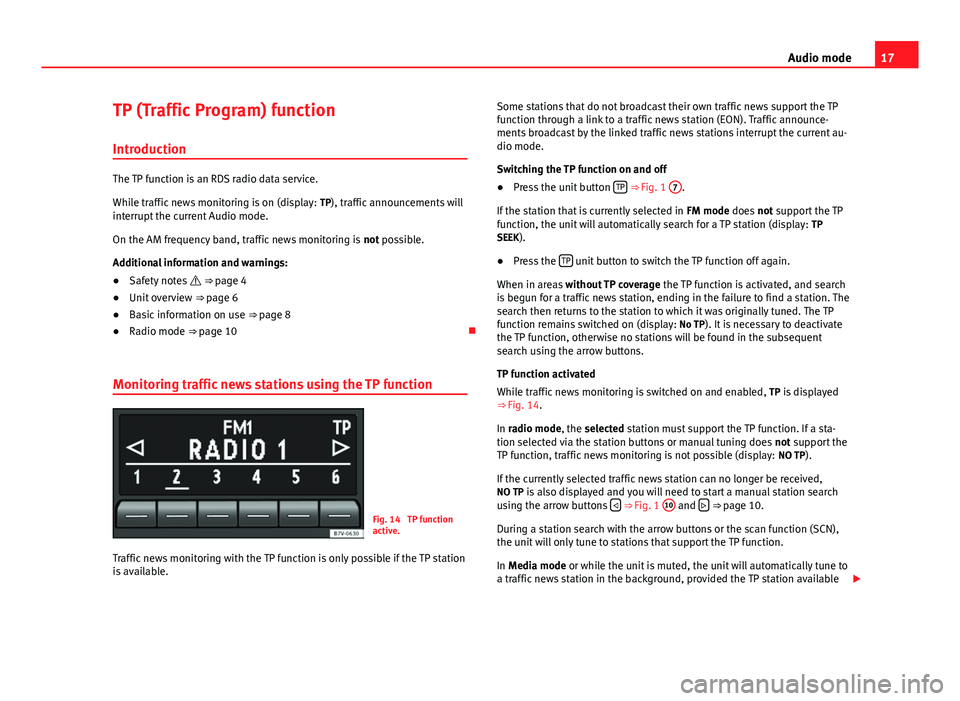
17
Audio mode
TP (Traffic Program) function
Introduction
The TP function is an RDS radio data service.
While traffic news monitoring is on (display: TP), traffic announcements will
interrupt the current Audio mode.
On the AM frequency band, traffic news monitoring is not possible.
Additional information and warnings:
● Safety notes ⇒ page 4
● Unit overview ⇒ page 6
● Basic information on use ⇒ page 8
● Radio mode ⇒ page 10
Monitoring traffic news stations using the TP function
Fig. 14 TP function
active.
Traffic news monitoring with the TP function is only possible if the TP station
is available. Some stations that do not broadcast their own traffic news support the TP
function through a link to a traffic news station (EON). Traffic announce-
ments broadcast by the linked traffic news stations interrupt the current au-
dio mode.
Switching the TP function on and off
● Press the unit button TP
⇒ Fig. 1
7.
If the station that is currently selected in FM mode does not support the TP
function, the unit will automatically search for a TP station (display: TP
SEEK).
● Press the TP
unit button to switch the TP function off again.
When in areas without TP coverage the TP function is activated, and search
is begun for a traffic news station, ending in the failure to find a station. The
search then returns to the station to which it was originally tuned. The TP
function remains switched on (display: No TP). It is necessary to deactivate
the TP function, otherwise no stations will be found in the subsequent
search using the arrow buttons.
TP function activated
While traffic news monitoring is switched on and enabled, TP is displayed
⇒ Fig. 14.
In radio mode, the selected station must support the TP function. If a sta-
tion selected via the station buttons or manual tuning does not support the
TP function, traffic news monitoring is not possible (display: NO TP).
If the currently selected traffic news station can no longer be received,
NO TP is also displayed and you will need to start a manual station search
using the arrow buttons
⇒ Fig. 1 10 and
⇒ page 10.
During a station search with the arrow buttons or the scan function (SCN),
the unit will only tune to stations that support the TP function.
In Media mode or while the unit is muted, the unit will automatically tune to
a traffic news station in the background, provided the TP station available
Page 19 of 37
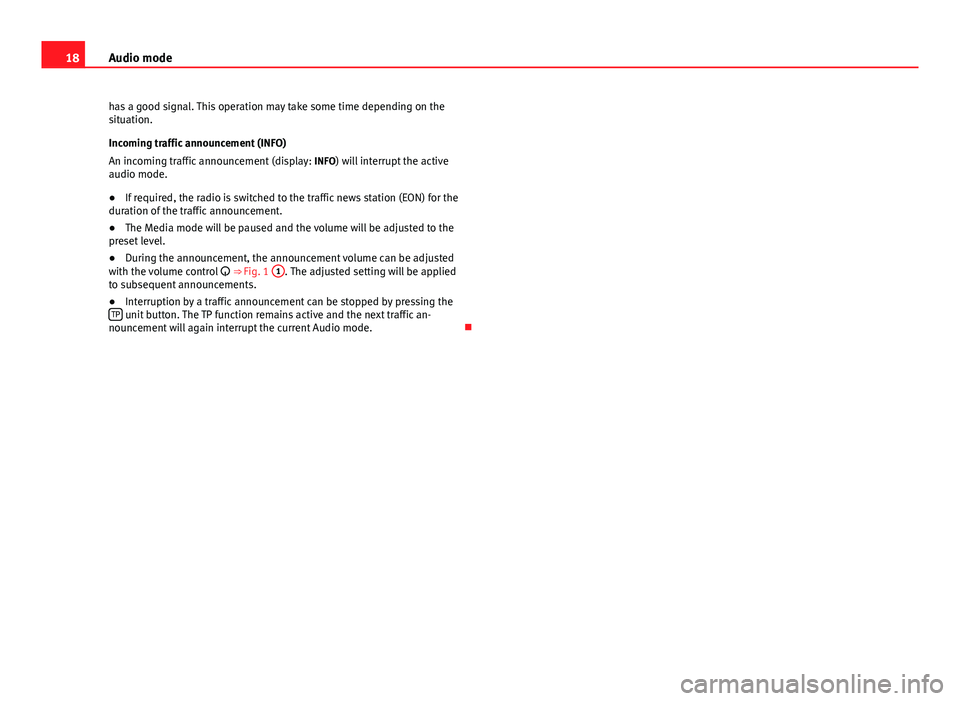
18Audio mode
has a good signal. This operation may take some time depending on the
situation.
Incoming traffic announcement (INFO)
An incoming traffic announcement (display: INFO) will interrupt the active
audio mode.
● If required, the radio is switched to the traffic news station (EON) for the
duration of the traffic announcement.
● The Media mode will be paused and the volume will be adjusted to the
preset level.
● During the announcement, the announcement volume can be adjusted
with the volume control ⇒ Fig. 1 1
. The adjusted setting will be applied
to subsequent announcements.
● Interruption by a traffic announcement can be stopped by pressing the
TP
unit button. The TP function remains active and the next traffic an-
nouncement will again interrupt the current Audio mode.
Page 20 of 37
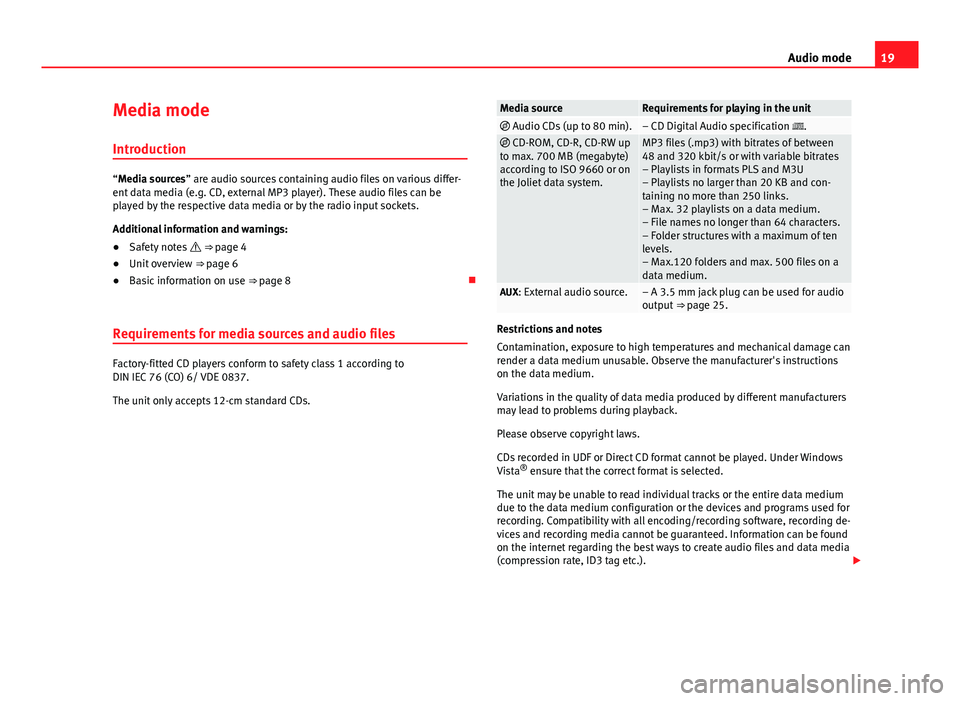
19
Audio mode
Media mode Introduction
“Media sources” are audio sources containing audio files on various differ-
ent data media (e.g. CD, external MP3 player). These audio files can be
played by the respective data media or by the radio input sockets.
Additional information and warnings:
● Safety notes ⇒ page 4
● Unit overview ⇒ page 6
● Basic information on use ⇒ page 8
Requirements for media sources and audio files
Factory-fitted CD players conform to safety class 1 according to
DIN IEC 76 (CO) 6/ VDE 0837.
The unit only accepts 12-cm standard CDs.
Media sourceRequirements for playing in the unit Audio CDs (up to 80 min).– CD Digital Audio specification . CD-ROM, CD-R, CD-RW up
to max. 700 MB (megabyte)
according to ISO 9660 or on
the Joliet data system.MP3 files (.mp3) with bitrates of between
48 and 320 kbit/s or with variable bitrates
– Playlists in formats PLS and M3U
– Playlists no larger than 20 KB and con-
taining no more than 250 links.
– Max. 32 playlists on a data medium.
– File names no longer than 64 characters.
– Folder structures with a maximum of ten
levels.
– Max.120 folders and max. 500 files on a
data medium.
AUX: External audio source.– A 3.5 mm jack plug can be used for audio
output ⇒ page 25.
Restrictions and notes
Contamination, exposure to high temperatures and mechanical damage can
render a data medium unusable. Observe the manufacturer's instructions
on the data medium.
Variations in the quality of data media produced by different manufacturers
may lead to problems during playback.
Please observe copyright laws.
CDs recorded in UDF or Direct CD format cannot be played. Under Windows
Vista ®
ensure that the correct format is selected.
The unit may be unable to read individual tracks or the entire data medium
due to the data medium configuration or the devices and programs used for
recording. Compatibility with all encoding/recording software, recording de-
vices and recording media cannot be guaranteed. Information can be found
on the internet regarding the best ways to create audio files and data media
(compression rate, ID3 tag etc.).
Page 21 of 37
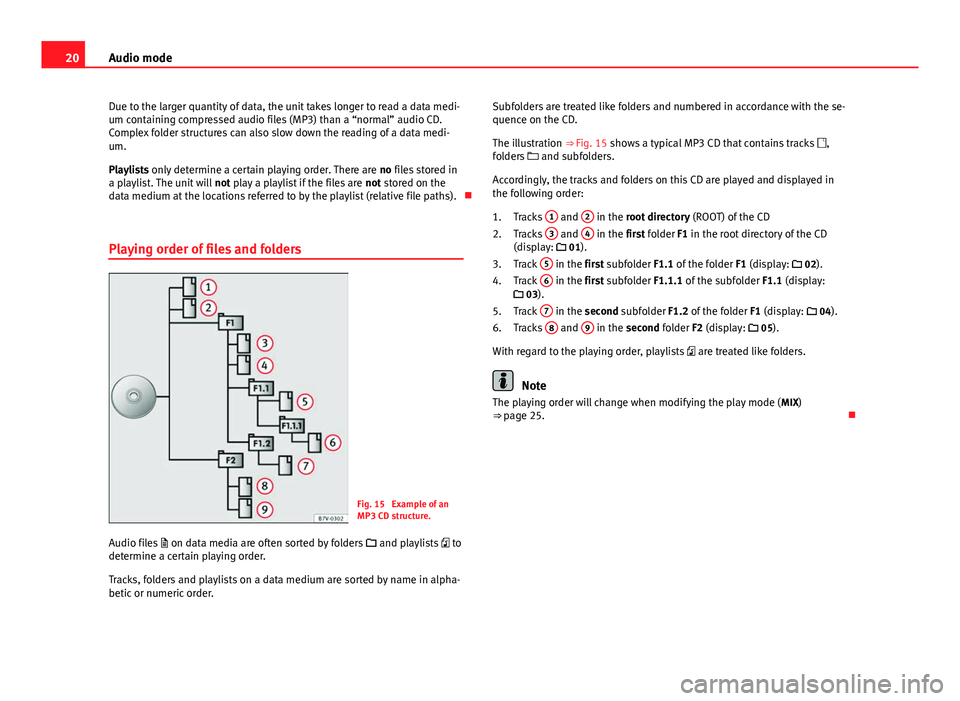
20Audio mode
Due to the larger quantity of data, the unit takes longer to read a data medi-
um containing compressed audio files (MP3) than a “normal” audio CD.
Complex folder structures can also slow down the reading of a data medi-
um.
Playlists only determine a certain playing order. There are no files stored in
a playlist. The unit will not play a playlist if the files are not stored on the
data medium at the locations referred to by the playlist (relative file paths).
Playing order of files and folders
Fig. 15 Example of an
MP3 CD structure.
Audio files on data media are often sorted by folders and playlists to
determine a certain playing order.
Tracks, folders and playlists on a data medium are sorted by name in alpha-
betic or numeric order. Subfolders are treated like folders and numbered in accordance with the se-
quence on the CD.
The illustration ⇒ Fig. 15 shows a typical MP3 CD that contains tracks
,
folders and subfolders.
Accordingly, the tracks and folders on this CD are played and displayed in
the following order: Tracks 1
and 2 in the root directory
(ROOT) of the CD
Tracks 3 and 4 in the first folder F1 in the root directory of the CD
(display: 01).
Track 5
in the first subfolder F1.1 of the folder
F1 (display: 02).
Track 6 in the first subfolder F1.1.1 of the subfolder
F1.1 (display:
03).
Track 7
in the second subfolder F1.2 of the folder
F1 (display: 04).
Tracks 8 and 9 in the second folder F2 (display:
05).
With regard to the playing order, playlists are treated like folders.
Note
The playing order will change when modifying the play mode ( MIX)
⇒ page 25.
1.
2.
3.
4.
5.
6.
Page 22 of 37
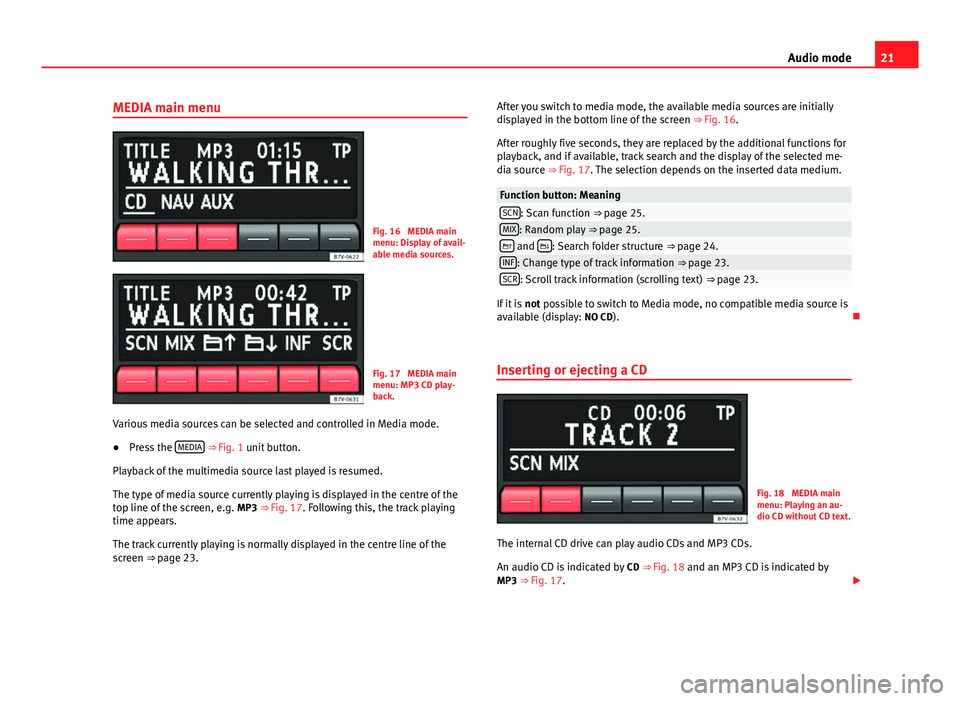
21
Audio mode
MEDIA main menu
Fig. 16 MEDIA main
menu: Display of avail-
able media sources.
Fig. 17 MEDIA main
menu: MP3 CD play-
back.
Various media sources can be selected and controlled in Media mode.
● Press the MEDIA
⇒ Fig. 1 unit button.
Playback of the multimedia source last played is resumed.
The type of media source currently playing is displayed in the centre of the
top line of the screen, e.g. MP3 ⇒ Fig. 17. Following this, the track playing
time appears.
The track currently playing is normally displayed in the centre line of the
screen ⇒ page 23. After you switch to media mode, the available media sources are initially
displayed in the bottom line of the screen
⇒ Fig. 16.
After roughly five seconds, they are replaced by the additional functions for
playback, and if available, track search and the display of the selected me-
dia source ⇒ Fig. 17. The selection depends on the inserted data medium.
Function button: MeaningSCN: Scan function ⇒ page 25.MIX: Random play ⇒ page 25. and : Search folder structure
⇒ page 24.INF: Change type of track information ⇒ page 23.SCR: Scroll track information (scrolling text) ⇒ page 23.
If it is not possible to switch to Media mode, no compatible media source is
available (display: NO CD).
Inserting or ejecting a CD
Fig. 18 MEDIA main
menu: Playing an au-
dio CD without CD text.
The internal CD drive can play audio CDs and MP3 CDs.
An audio CD is indicated by CD
⇒ Fig. 18 and an MP3 CD is indicated by
MP3 ⇒ Fig. 17.
Page 23 of 37
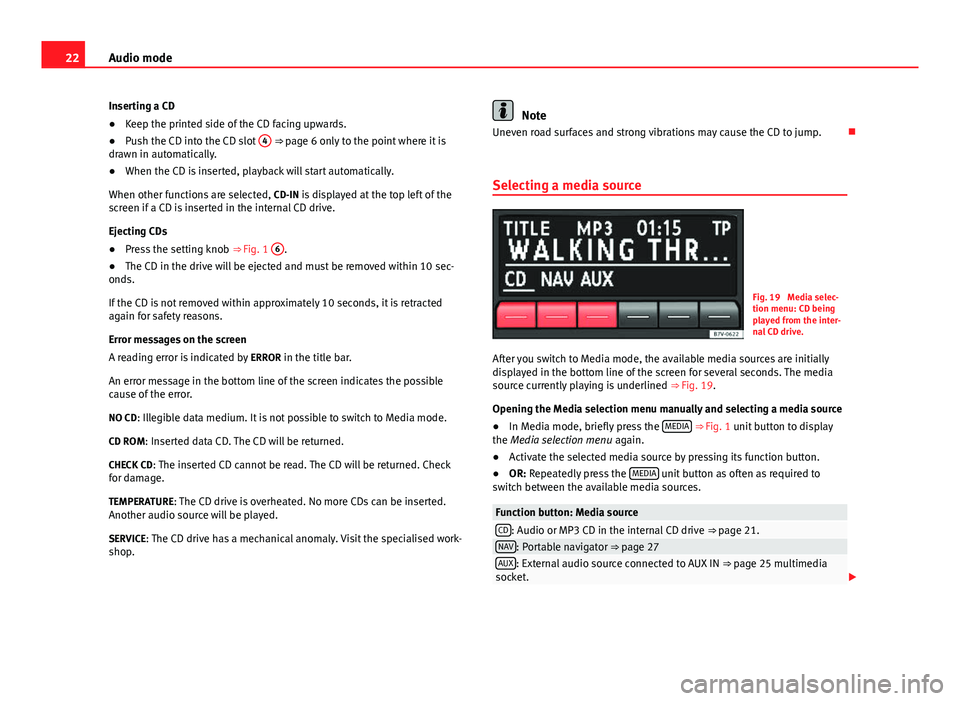
22Audio mode
Inserting a CD
● Keep the printed side of the CD facing upwards.
● Push the CD into the CD slot 4
⇒ page 6 only to the point where it is
drawn in automatically.
● When the CD is inserted, playback will start automatically.
When other functions are selected, CD-IN is displayed at the top left of the
screen if a CD is inserted in the internal CD drive.
Ejecting CDs
● Press the setting knob ⇒ Fig. 1 6
.
● The CD in the drive will be ejected and must be removed within 10 sec-
onds.
If the CD is not removed within approximately 10 seconds, it is retracted
again for safety reasons.
Error messages on the screen
A reading error is indicated by ERROR in the title bar.
An error message in the bottom line of the screen indicates the possible
cause of the error.
NO CD: Illegible data medium. It is not possible to switch to Media mode. CD ROM: Inserted data CD. The CD will be returned.
CHECK CD: The inserted CD cannot be read. The CD will be returned. Check
for damage.
TEMPERATURE: The CD drive is overheated. No more CDs can be inserted.Another audio source will be played.
SERVICE: The CD drive has a mechanical anomaly. Visit the specialised work- shop.
Note
Uneven road surfaces and strong vibrations may cause the CD to jump.
Selecting a media source
Fig. 19 Media selec-
tion menu: CD being
played from the inter-
nal CD drive.
After you switch to Media mode, the available media sources are initially
displayed in the bottom line of the screen for several seconds. The media
source currently playing is underlined ⇒ Fig. 19.
Opening the Media selection menu manually and selecting a media source
● In Media mode, briefly press the MEDIA
⇒ Fig. 1 unit button to display
the Media selection menu again.
● Activate the selected media source by pressing its function button.
● OR: Repeatedly press the MEDIA
unit button as often as required to
switch between the available media sources.
Function button: Media sourceCD: Audio or MP3 CD in the internal CD drive ⇒ page 21.NAV: Portable navigator ⇒ page 27AUX: External audio source connected to AUX IN ⇒ page 25 multimedia
socket.
Page 24 of 37
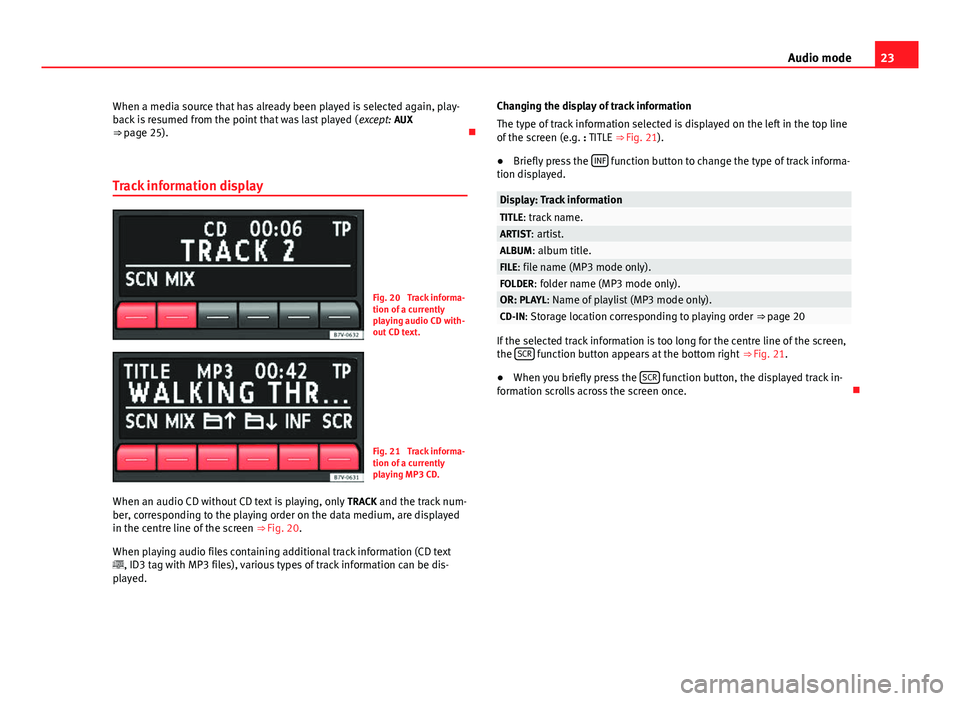
23
Audio mode
When a media source that has already been played is selected again, play-
back is resumed from the point that was last played ( except: AUX
⇒ page 25).
Track information display
Fig. 20 Track informa-
tion of a currently
playing audio CD with-
out CD text.
Fig. 21 Track informa-
tion of a currently
playing MP3 CD.
When an audio CD without CD text is playing, only TRACK and the track num-
ber, corresponding to the playing order on the data medium, are displayed
in the centre line of the screen ⇒ Fig. 20.
When playing audio files containing additional track information (CD text
, ID3 tag with MP3 files), various types of track information can be dis-
played. Changing the display of track information
The type of track information selected is displayed on the left in the top line
of the screen (e.g. : TITLE ⇒ Fig. 21).
● Briefly press the INF
function button to change the type of track informa-
tion displayed.
Display: Track informationTITLE: track name.ARTIST: artist.ALBUM: album title.FILE: file name (MP3 mode only).FOLDER: folder name (MP3 mode only).OR: PLAYL: Name of playlist (MP3 mode only).CD-IN: Storage location corresponding to playing order ⇒ page 20
If the selected track information is too long for the centre line of the screen,
the SCR function button appears at the bottom right
⇒ Fig. 21.
● When you briefly press the SCR
function button, the displayed track in-
formation scrolls across the screen once.